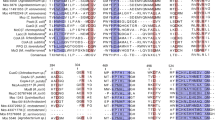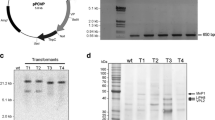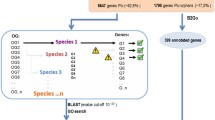Abstract
The white-rot fungiPhanerochaete chrysosporium andSporotrichum pulverulentum are now the classic lignin degrading organisms.P. chrysosporium is the better characterized with respect to the physiology of lignin degradation, whereasS. pulverulentum has been extensively studied to determine the mechanism of cellulose degradation and lignin-related aromatic metabolism. The organisms are very similar and some workers consider thatP. chrysosporium is the perfect form of a strain, whereasS. pulverulentum is the imperfect form. We have compared the genomic DNA of the two organisms and find that they differ in the proportion of methylated bases. Gene libraries of both strains have been constructed using the bacteriophage vector λgt WES.T5-622 inEscherichia coli and we have used the clones to compare the distribution of restriction sites in the two DNAs. Results of DNA hybridization experiments will be presented.
Pleiotropic mutants defective in lignin degradation have been isolated both by Ander and Eriksson and by Gold and coworkers, by screening for loss of phenol oxidase activity. It is thought that a peroxidase gives the phenol oxidase reaction in these organisms. We have also isolated a number of classes of phenol oxidase-less mutants after γ-irradiation using a cobalt-60 source.
In these fungi, lignin degradation is not an inducible activity. We have examined the degradation of14C-(lignin)-grass lignocellulose by white-rot fungi.S. pulverulentum andP. chrysosporium produce14CO2 from this natural substrate after a lag period as they do with the synthetic DHPs used by other workers. Despite the presence of substantial amounts of phenolic acids esterified both to lignin and carbohydrate in grass lignocellulose,14CO2 is only evolved once the organism has started to express secondary metabolic functions after nitrogen depletion. A dramatic increase in intracellular cyclic AMP occurs just prior to the onset of lignolytic activity (and of the production of the secondary metabolite veratryl alcohol). The cyclic AMP level remains higher than in control cultures growing with excess nitrogen. Glutamate is known to suppress14CO2 evolution from lignin and we have established that its addition to cultures during the time when14CO2 is first evolved produces a rapid decrease in intracellular cAMP and eliminates14CO2 evolution within 24 h. This suggests that lignin degradation is regulated by the level of intracellular cAMP.
We have isolated RNA from cultures grown with excess nitrogen and under nitrogen limitation. As expected, cultures grown under nitrogen limitation produce less biomass and RNA than those grown in nutrient excess. In both, by far the largest component is ribosomal. However, messenger RNA can be enriched by affinity chromatography using their polyA tails to specifically bond it to absorbents. The enriched mRNA has been translated in vitro and we are using it as templates to make complementary DNA (cDNA) with the enzyme reverse transcriptase. The gene libraries facilitate the analysis of the regulation of lignin degradation and related secondary metabolic activities. Using specific probes of mRNA or cDNA, clones in the gene library can be identified. We hope that study of the isolated genes and the sequences regulating their expression will cast new light on the control of ligninolytic functions and eventually allow sophisticated techniques of genetic manipulation such as site-specific mutagenesis to be employed in commercial strain construction.
InS. pulverulentum, carbohydrate metabolism also appears to be coordinately regulated in a complex manner. Cellulases, xylanases, mannanase, and Β-glucosidase are all induced during growth on cellulose, but growth on xylan seems to produce excretion of xylanases only. We have exploited the high resolving power of O’Farrell 2-dimensional gel electrophoresis to analyze the protein populations in cultures at different stages of growth and using different lignin and carbohydrate substrates. The sequence of proteins produced during the onset of secondary metabolism is being analyzed with the aid of computer cataloging and analysis techniques.
White-rot fungi are, however, not the only organisms capable of lignin degradation. We have been isolating and studying thermophilic actinomycetes that appear to be ligninolytic. Our actinomycetes cannot totally mineralize14C-(lignin) lignocellulose, but do appear to be able to solubilize the14C quite efficiently. We are studying the solubilized products of the thermophilic attack to determine their molecular weight and structure. We hope that these will prove to be useful in development of new processes for conversion of lignins into products of commercial interest.
Similar content being viewed by others
Author information
Authors and Affiliations
Additional information
Supported by British Petroleum Venture Research Unit.
Rights and permissions
About this article
Cite this article
Broda, P., MacDonald, M., Raeder, U. et al. Genetic methods for studying lignin degradation. Appl Biochem Biotechnol 9, 321–322 (1984). https://doi.org/10.1007/BF02798956
Issue Date:
DOI: https://doi.org/10.1007/BF02798956




